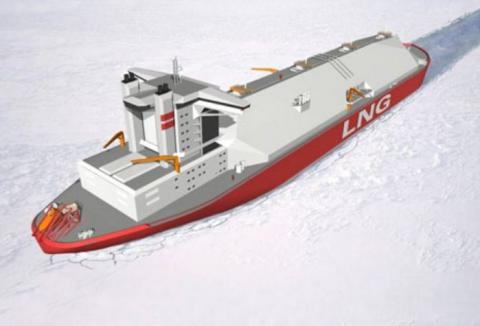For many months now, those of us with interests in Polar shipping have been awaiting the news on the selection of shippers and exporters for Russia’s ambitious Yamal LNG project. On 15 July the Russian Prime Minister Dmitry Medvedev announced Russia had granted LNG export rights to OJSC Gazprom, Gazprom Export, OJSC Rosneft and OJSC Yamal LNG. Within the same week as the Russian announcement came word that at least some of the export shipping from Yamal will be done by Mitsui OSK (partnered with China Shipping Development Co)with three Arctic LNGCs and Teekay LNG Partners (partnered CNOOC-China Merchants) with six Arctic LNGCs to be built by DSME in Korea. Russia’s SOVCOMFLOT had previously confirmed an order for the first of this class of Arctic LNGC. The final five vessels of the planned fleet of 15 are yet to be contracted but are expected to be under SOVCOMFLOT’s flag. Nothing built previously can compare to this new fleet of highly capable and complex ships. These 172,000cbm ships will be 299m in length with a 50m breadth and with a double acting design, able to break ice 2.1m thick. Furthermore, they will be designed to operate in extremely cold winter conditions along the Russian Arctic coast. Also part of the Yamal shipping fleet will be a series of newbuild dedicated harbour support, port and line icebreakers though the LNGC’s will be more than capable of handling ice conditions expected on their own. This, however, does require a two-pronged routing plan. Yamal’s exports are envisioned to be split between European and Asian markets. During the heavy winter ice period, export westward to Europe through much less severe ice is anticipated. Summer export will focus eastward to Asia via the Northern Sea Route, which can still experience heavy ice in chokepoints and where icebreaker LNGC’s will still be required to ensure timely passage. The operation of this fleet of icebreakers and icebreaking LNGCs will require a substantial increase in suitably experienced ice navigation bridge officers and crews familiar with extreme cold operations. Even given the very well designed ships with a focus on protection from cold and icebreaking capability operation will require a different set of prerequisites in selecting crew. Wisely, the overall plan does indentify the need to bring in very experienced Ice Navigators to advise and train masters and bridge officers during ice transits, and crew training and familiarization in extreme cold operations is also identified. The additional requirements continue to be included in spite of the apparent relaxed attitude toward ice training and experience presently included in the IMO’s draft Polar Code. In the present draft Polar Code the employment of experienced Ice Navigators was removed and replaced by an undefined requirement for “basic and advanced training” of all bridge watchkeeping officers. Reblog
Recent Posts
- My Belated Return to the Blogosphere
- RV Mirai Arctic Mission 2014 Post #10 – The Polar Code – Better Sense Prevails at IMO?
- RV Mirai Arctic Mission 2014 Post #9 – Protecting the Fragile Arctic Environment
- RV Mirai Arctic Mission 2014 Post #8 – The Known Unknowns
- RV Mirai Arctic Mission 2014 Post #7 – Nobody Here But Us
Tags
arctia
Arctic
arctic communications
arctic environment
Arctic LNG
ArcticMythBusters
arctic research
arctic search and rescue
arctic shipping
arctic weather
Canadian Coast Guard
fednav
global climate change
ice navigation
ice navigator
IMO
imo polar code
mirai
mv nunavik
Nautinst
polar code
polar lows
Polar Shipping
rv mirai
SDC 1
shipping
Sir John Frankin
UNCLOS
Yamal

